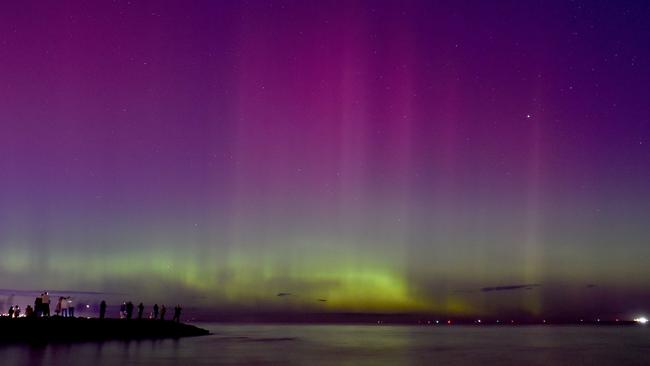Experts reveal new chance of auroras across Australia and reveal the best place to see one
Aussies turned their heads to the sky just months ago for what is usually a rare experience, but the lucky country will get another chance to witness it tonight.
Environment
Don't miss out on the headlines from Environment. Followed categories will be added to My News.
Australians could be in for another glimpse of a rare weather event.
Experts are keeping a close eye on increased activity on the sun, with the chance auroras could be visible on Tuesday night.
Auroras, known as the Southern Lights, are usually seen from Tasmania.
However, May brought in the biggest geomagnetic storm in nearly 20 years, giving stargazers in Victoria, South Australia, and across the globe prime views of the rare event.
Hues of pink, purple and green lit up the sky, delighting regular Aussies and avid stargazers alike.
Now, another geomagnetic storm is expected to hit, with it forecast to be strongest on Tuesday evening.

Bureau of Meteorology senior meteorologist Miriam Bradbury confirmed there was a chance of seeing the colourful spectacle but not as good a chance as there was back in May.
People in southern Victoria and Tasmania will have the best chance at seeing auroras.
“At this point the southwest and central coast of Victoria are looking the most promising,” she said.
The Gippsland coast may also have a shot, though conditions are expected to be a little cloudy.
“Tasmania is probably likely – we’re going to see partly cloudy conditions across the state, and it’s not to say you won’t see any auroras, but you might be fighting with those cloudy conditions,” Ms Bradbury said.
“I think what's really going to be a determining factor is how much cloud we have lingering. Unfortunately, we do have cloudy conditions over this week.”
It’s likely much of NSW will miss out on the weather event as well as Western Australia.
The weather event is caused by coronal mass ejections – clouds of charged particles and magnetic field that can interact with earth’s magnetic field and atmosphere, bringing about colourful auroras.
RMIT School of Science associate professor Brett Carter said solar flares and coronal mass ejections had been observed near Earth.
“At least two coronal mass ejections are approaching Earth. They are predicted to merge into one disturbance that is expected to arrive Tuesday morning onwards,” he said.
“The scale of the geomagnetic storm that these eruptions cause is expected to be largest the evening of Tuesday 30 July, giving Australians in southern parts of Victoria and Western Australia a chance at seeing some aurora – if conditions are right.”

Ms Bradbury said the space weather team was suggesting that it was going to be a G2 or G3 storm, which is moderate to strong.
It’s unclear exactly what time the solar storm will arrive in Australia, and the likelihood of catching an aurora is “highly uncertain”, according to Professor Carter.
“The most significant issue in predicting the impact of such events on Earth is that we don’t know the magnetic field within the eruption. Disturbances with southward magnetic field have significantly larger impacts than those that are northward,” Professor Carter said.
“Currently, we don’t have a reliable way to predict the magnetic field within solar eruptions.”
More research is needed, as well as more data and better models to predict the space environment, Professor Carter said.
“There’s no way to know for sure how this space weather event is going to play out. We will just have to watch the data come in and see whether the conditions are suitable for aurora viewing or not,” he said.
“To know whether it’s worth packing up the camera gear and heading for some dark, clear skies, keep an eye on the space weather data coming in and keep an eye on your social media feeds. People are very quick to share their amazing aurora photos online.”
Dark skies are your best chance of seeing the auroras.
Originally published as Experts reveal new chance of auroras across Australia and reveal the best place to see one




